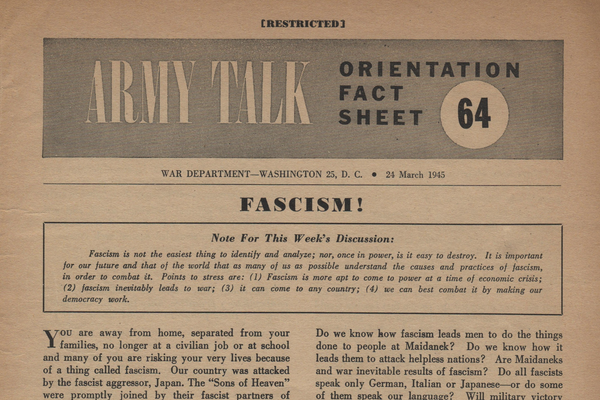The Army Warned Troops in 1945 of the Danger of Fascism. That Warning Rings True Today

On March 25, 1945, the United States Army issued “Fact Sheet #64: Fascism!” to promote discussions amongst American troops about fascism as the war in Europe wound down to a close. Discussion leaders were alerted “Fascism is not the easiest thing to identify and analyze; nor, once in power, is it easy to destroy. It is important for our future and that of the world that as many of us as possible understand the causes and practices of fascism, in order to combat it.”
It is worth revisiting the Army’s warnings as Donald Trump and MAGA Republicans denounce legal due process and threaten civil war.
Four key points were addressed in the Army fact sheet to be included in discussions.
(1) Fascism is more apt to come to power at a time of economic crisis;
(2) Fascism inevitably leads to war;
(3) It can come to any country;
(4) We can best combat it by making our democracy work.
The fact sheet described findings by war correspondent Cecil Brown who toured the United States after leaving Europe. Brown discovered that most Americans he talked with were “vague about just what fascism really means. He found few Americans who were confident they would recognize a fascist if they saw one.” The War Department was concerned that ignorance about fascism could make it possible for it to emerge in the United States and issued recommendations for how to prevent it.
As a simple definition, the War Department described fascism as the “opposite of democracy. The people run democratic governments, but fascist governments run the people. Fascism is government by the few and for the few.” Fascists remain in power through “skillful manipulation of fear and hate, and by false promise of security . . . At the very time that the fascists proclaimed that their party was the party of the ‘average citizen,’ they were in the pay of certain big industrialists and financiers . . . They played political, religious, social, and economic groups against each other and seized power while these groups struggled against each other.”
The War Department acknowledged that the United States had
native fascists who say that they are ‘100 percent American’ . . . [A]t various times and places in our history, we have had sorry instances of mob sadism, lynchings, vigilantism, terror, and suppression of civil liberties. We have had our hooded gangs, Black Legions, Silver Shirts, and racial and religious bigots. All of them, in the name of Americanism, have used undemocratic methods and doctrines which experience has shown can be properly identified as ‘fascist’.
The War Department warned,
An American fascist seeking power would not proclaim that he is a fascist. Fascism always camouflages its plans and purposes . . . Any fascist attempt to gain power in America would not use the exact Hitler pattern. It would work under the guise of ‘super-patriotism’ and ‘super-American- ism’.
The War Department identified three attitudes and practices that fascists share in common. Fascists pit “religious, racial, and economic groups against one another in order to break down national unity . . . In the United States, native fascists have often been anti-Catholic, anti-Jew, anti-Negro, anti-Labor, anti- foreign-born.” Fascists also “deny the need for international cooperation” and that “all people — regardless of color, race, creed, or nationality have rights.” They “substitute a perverted sort of ultra-nationalism which tells their people that they are the only people in the world who count.” Finally, for fascists, the “[i]ndiscriminate pinning of the label ‘Red’ on people and proposals which one opposes is a common political device.”
Learning to identify American fascists and detect their techniques was not going to be easy, but
it is vitally important to learn to spot them, even though they adopt names and slogans with popular appeal, drape themselves with the American flag, and attempt to carry out their program in the name of the democracy they are trying to destroy . . . In its bid for power, it is ready to drive wedges that will disunite the people and weaken the nation. It supplies the scapegoat — Catholics, Jews, Negroes, labor unions, big business — any group upon which the insecure and unemployed
are willing to blame.
They become frightened, angry, desperate, confused. Many, in their misery, seek to find somebody to blame . . . The resentment may be directed against minorities — especially if undemocratic organizations with power and money can direct our emotions and thinking along these lines.
The goal of the fascist doctrine is to prevent “men from seeking the real cause and a democratic solution to the problem.”
Fascists may talk about freedom, but
freedom . . . involves being alert and on guard against the infringement not only of our own freedom but the freedom of every American. If we permit discrimination, prejudice, or hate to rob anyone of his democratic rights, our own freedom and all democracy is threatened.